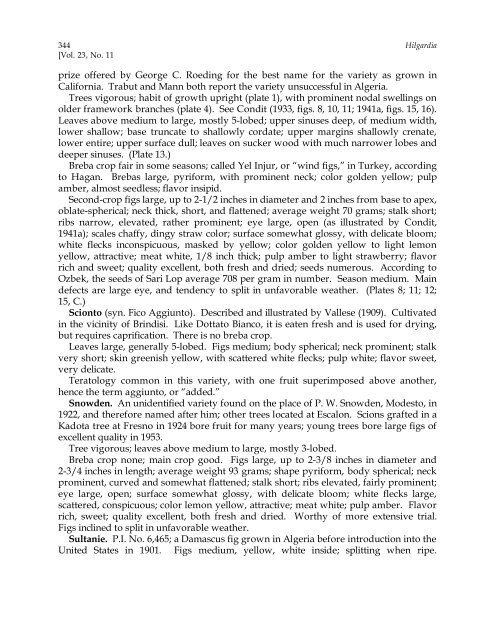Fig Varieties: A Monograph - uri=ucce.ucdavis
Fig Varieties: A Monograph - uri=ucce.ucdavis
Fig Varieties: A Monograph - uri=ucce.ucdavis
You also want an ePaper? Increase the reach of your titles
YUMPU automatically turns print PDFs into web optimized ePapers that Google loves.
344 Hilgardia<br />
[Vol. 23, No. 11<br />
prize offered by George C. Roeding for the best name for the variety as grown in<br />
California. Trabut and Mann both report the variety unsuccessful in Algeria.<br />
Trees vigorous; habit of growth upright (plate 1), with prominent nodal swellings on<br />
older framework branches (plate 4). See Condit (1933, figs. 8, 10, 11; 1941a, figs. 15, 16).<br />
Leaves above medium to large, mostly 5-lobed; upper sinuses deep, of medium width,<br />
lower shallow; base truncate to shallowly cordate; upper margins shallowly crenate,<br />
lower entire; upper surface dull; leaves on sucker wood with much narrower lobes and<br />
deeper sinuses. (Plate 13.)<br />
Breba crop fair in some seasons; called Yel Injur, or “wind figs,” in Turkey, according<br />
to Hagan. Brebas large, pyriform, with prominent neck; color golden yellow; pulp<br />
amber, almost seedless; flavor insipid.<br />
Second-crop figs large, up to 2-1/2 inches in diameter and 2 inches from base to apex,<br />
oblate-spherical; neck thick, short, and flattened; average weight 70 grams; stalk short;<br />
ribs narrow, elevated, rather prominent; eye large, open (as illustrated by Condit,<br />
1941a); scales chaffy, dingy straw color; surface somewhat glossy, with delicate bloom;<br />
white flecks inconspicuous, masked by yellow; color golden yellow to light lemon<br />
yellow, attractive; meat white, 1/8 inch thick; pulp amber to light strawberry; flavor<br />
rich and sweet; quality excellent, both fresh and dried; seeds numerous. According to<br />
Ozbek, the seeds of Sari Lop average 708 per gram in number. Season medium. Main<br />
defects are large eye, and tendency to split in unfavorable weather. (Plates 8; 11; 12;<br />
15, C.)<br />
Scionto (syn. Fico Aggiunto). Described and illustrated by Vallese (1909). Cultivated<br />
in the vicinity of Brindisi. Like Dottato Bianco, it is eaten fresh and is used for drying,<br />
but requires caprification. There is no breba crop.<br />
Leaves large, generally 5-lobed. <strong>Fig</strong>s medium; body spherical; neck prominent; stalk<br />
very short; skin greenish yellow, with scattered white flecks; pulp white; flavor sweet,<br />
very delicate.<br />
Teratology common in this variety, with one fruit superimposed above another,<br />
hence the term aggiunto, or “added.”<br />
Snowden. An unidentified variety found on the place of P. W. Snowden, Modesto, in<br />
1922, and therefore named after him; other trees located at Escalon. Scions grafted in a<br />
Kadota tree at Fresno in 1924 bore fruit for many years; young trees bore large figs of<br />
excellent quality in 1953.<br />
Tree vigorous; leaves above medium to large, mostly 3-lobed.<br />
Breba crop none; main crop good. <strong>Fig</strong>s large, up to 2-3/8 inches in diameter and<br />
2-3/4 inches in length; average weight 93 grams; shape pyriform, body spherical; neck<br />
prominent, curved and somewhat flattened; stalk short; ribs elevated, fairly prominent;<br />
eye large, open; surface somewhat glossy, with delicate bloom; white flecks large,<br />
scattered, conspicuous; color lemon yellow, attractive; meat white; pulp amber. Flavor<br />
rich, sweet; quality excellent, both fresh and dried. Worthy of more extensive trial.<br />
<strong>Fig</strong>s inclined to split in unfavorable weather.<br />
Sultanie. P.I. No. 6,465; a Damascus fig grown in Algeria before introduction into the<br />
United States in 1901. <strong>Fig</strong>s medium, yellow, white inside; splitting when ripe.
















![Fig Trees in North Carolina [Archive] - IDigMyGarden ... - Figs 4 Fun](https://img.yumpu.com/26905320/1/190x245/fig-trees-in-north-carolina-archive-idigmygarden-figs-4-fun.jpg?quality=85)